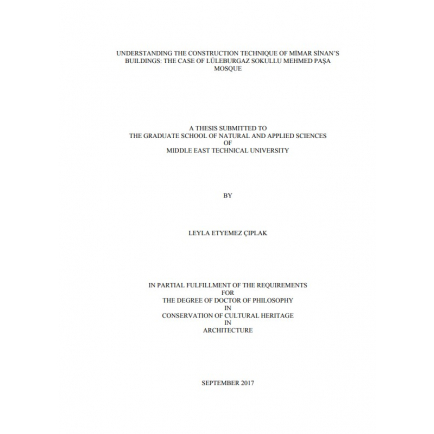
Understanding the construction technique of Mimar Sinan’s buildings: the case of Lüleburgaz Sokullu Mehmed Paşa Mosque
Date Added
26/06/2022
Content Type
Dissertation
Category
Ph.D.
Link to Content
Subject Area
Mosques
Author
LEYLA ETYEMEZ ÇIPLAK
Publisher Name
LEYLA ETYEMEZ ÇIPLAK
Year of Publication
2017
Description
This dissertation constructs a comprehensive understanding of the construction techniques applied and developed by Mimar Sinan, which underlie the structural characteristics of 16th century Ottoman Architecture. Conducting a research into the literature on Classical Ottoman Architecture and Mimar Sinan’s buildings, the study distinguishes Sokullu Mehmed Paşa Menzil Complexes in Lüleburgaz, Havsa and Payas among the buildings and complexes as known to be designed by Mimar Sinan. It focuses on the mosques of these three complexes, as mosques embody complicated systems and techniques of construction to respond spatial and structural challenges, and compares them to assess the changes and similarities in the construction techniques, as all of them are commissioned by the same donor and in the same decade. Among the three menzil complexes, the mosque in Lüleburgaz becomes prominent as Mimar Sinan was most probably personally involved in its construction process, while the other two in Havsa and Payas are supposed to be designed by Mimar Sinan and later constructed by his kalfas and local architects. After the literature survey that enables the specification of cases to be analyzed and evaluated, the study expands with pre-site survey and site surveys of each complex, all of which is represented by an individual catalogue including the restitutive and current site plans of the complex accompanied with its the historical, architectural and constructional features, and the three-dimensional mass model, plans, sections, elevations, and system details of the mosques in the respective complexes. In respect to the information gathered and produced through surveys, the study focuses on Lüleburgaz Sokullu Mehmed Paşa Mosque and develops a particular methodology to analyze the construction technique in the mosque by a two-fold approach: “decomposition” and “re-composition.” The methodology advances a “coding system” based on the analytical interpretation of sections showing system details, which are produced not only by the knowledge accessible in literature or visible in actual buildings but also by the critical interpretation of yet to be known or possible or unknown structural components, elements and materials. The coding system aims at an analytical and structural decomposition of building components, which contributes to the understanding of construction technique by the evaluation and classification of elements according to their structural behaviors and architectural purposes. The decomposed elements are individually studied with section drawings addressing to the changes in material, structural system and construction technique, and then re-composed to illustrate the techniques and processes of construction. Aiming at constructing a comprehensive understanding of construction technique in Mimar Sinan’s buildings, in particular, and 16th century Ottoman Architecture in general, this study develops a methodological approach and a catalogue system applicable in various studies on historical buildings from different periods to establish a database for expanding architectural knowledge not only in construction technique but also for guiding the projects in restoration and conservation.
Files
English
Architecture, Ottoman., Architecture, Islamic., Mosques
LEYLA ETYEMEZ ÇIPLAK
Graduate School of Natural and Applied Sciences, Thesis
2017





